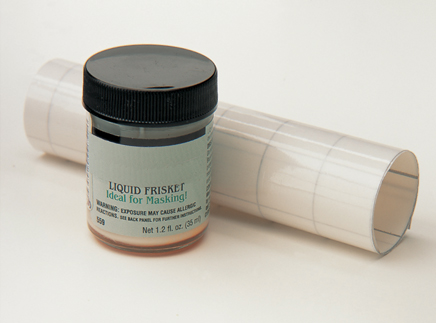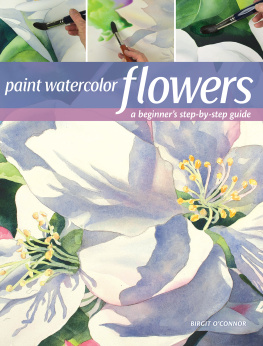
How to Draw & Paint
Florals & Botanicals
The natural splendor of flowers and botanicals makes them irresistible subjects for artistic expressionand watercolor is the perfect medium for painting a delightful range of floral shapes, colors and textures. Watercolor can be applied opaquely or translucently, and you can layer colors to achieve depth and intensity. You also can create a variety of special effects using simple household items, such as salt, sponges, and tissues. In this book, you will learn about the anatomy of a flower and its basic shapes, how to set up attractive floral arrangements, and how to use form, value, and color to render amazingly lifelike flowers. You also will discover the exciting properties of watercolor and learn how to paint an array of flowersfrom delicate orchids to bold birds of paradisethat will inspire you to capture your own floral scenes!

2008, 2010 Walter Foster Publishing, Inc. Artwork on pages 411, 1419, and 2225 Joan Hansen. Artwork on pages 1213 and 2021 Geri Medway.
Artwork on pages 2627 and 3031 Caroline Linscott. Artwork on pages 2829 Barbara Fudurich. All rights reserved. This book has been published to aid the aspiring artist. Reproduction of the work for study or finished art is permissible. Any art drawn or photomechanically reproduced from this publication for commercial purposes is forbidden without written consent from the publisher, Walter Foster Publishing, Inc.
Digital edition: 978-1-61059-862-0
Softcover edition: 978-1-60058-120-5
CONTENTS
Purchasing Tools and Materials
WITH THE AMAZING SELECTION of paints, brushes, papers, and other materials available, every visit to the art supply store is an adventure full of excitement and possibilities. Instead of picking out one of everything, refer to the suggested supply list in the box at right. You can purchase a limited number of supplies, but always invest in the best you can afford. You always can buy additional materials as you develop your skills and personal painting style. If youd like to learn more about watercolor tools and materials, refer to Watercolor & Acrylic Painting Materials by William F. Powell in Walter Fosters Artists library series.
Buying Paints
Watercolor paints are available in tubes, pans, and cakes. Most artists choose tube water colors because they are already moist, which makes them easy to use, and they allow you to squeeze out a large amount of color quickly and easily. Pan and cake paints, however, are small and light, which makes them convenient for travel. Whichever type you choose, be sure to select artist-grade paints. Student-grade paints are mixed with more fillers and additives, which decrease the intensity of the colorsand your painting. Artist-grade paints are made with purer pigments, so the colors are truer and richer.

PAN PAINTS Pan or cake paints are typically stored in a watercolor box, which doubles as a mixing palette. To use, moisten the block with a wet brush and scrub the pigment loose.
Choosing Colors
A beginners color palette doesnt have to be extensive. In theory, all an artist really needs are the three primaries: red, yellow, and blue. But in practice, its more convenient and practical to select a small array of colors. Even with a minimal set, or limited palette, like the one shown, youll be able to mix just about any color you may need.

CHOOSING PAINTS Lightfast paint retains its color after being exposed to light over time. Colors rated I (excellent) or II (very good) will last the longest. Pigments with low ratings are sometimes referred to as fugitive colors because they fade over time. If you dont see the rating on the tube, ask your art supply store for an information sheet from the manufacturer.
Checking your Supply list
Heres a list of the basic supplies youll need to get started painting with watercolor. (For specifics, refer to the suggested brushes and colors shown below.)
 Five paintbrushes
Five paintbrushes
 Ten watercolor paints
Ten watercolor paints
 Watercolor paper
Watercolor paper
 Mixing palette
Mixing palette
 Drawing board or easel
Drawing board or easel
 At least two water containersone for rinsing brushes and one for clean water
At least two water containersone for rinsing brushes and one for clean water

STARTING OUT Each artist develops his or her own favorite palette of colorsand you will too. The basic palette will get you started.
Looking at Brushes
Watercolor brushes are categorized by size, shape, and hair type. Brush size is indicated either in inches or by a number, but the numbering system varies among the different brands. For example, although a #2 brush is usually very small, the length and width of the bristles may differ slightly from manufacturer to manufacturer. In this book, brushes are referred to as small, medium, or large, so choose the sizes that fit your subjects. Brush shapes determine the type of strokes you createrounds will yield a narrower line than flats will. Hair types are either natural or synthetic; both will do the job, but natural hairs generally cost more. For beginners, the five brushes shown make a good starter set.





DISTINGUISHING BETWEEN BRUSHES There are many styles of brushes, each with its own function. For instance, a flexible flat brush is invaluable for painting thick, even bands of color; the firm point of a small round brush is ideal for detail work; and a liner or rigger brush is great for painting very fine lines.

Next page











 Five paintbrushes
Five paintbrushes





